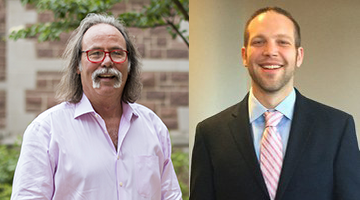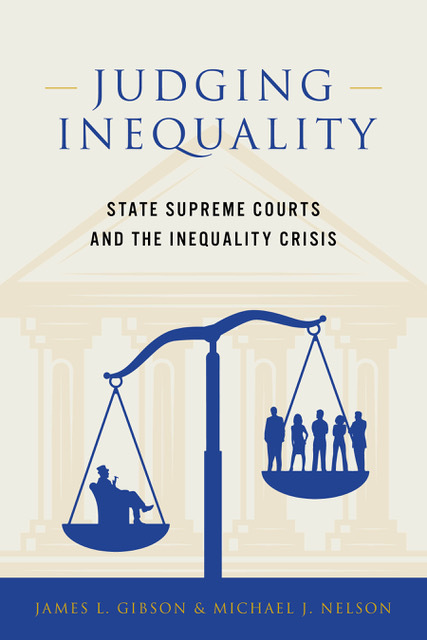In “Judging Inequality,” James L. Gibson and Michael J. Nelson account for 26 years of political maneuvering to influence states’ highest courts.

State supreme courts do not protect minority interests but instead reflect the will of a state’s political majority, according to a new book by James L. Gibson, the Sidney W. Souers Professor of Government, and Michael J. Nelson, PhD ’14. In Judging Inequality: State Supreme Courts and the Equality Crisis, the authors present findings from a multi-year study of state supreme court cases that show state high courts often contributing to a growing trend of inequality in the United States.
Schools in the U.S. commonly teach that the judiciary is a minoritarian institution that protects the rights of unpopular minorities. The nation’s courts are able to maintain this role because of their purported independence. Yet, Gibson and Nelson find that this assumption does not reflect the political reality of how state supreme courts are seated and subsequently decide cases.
Those state supreme courts that do act as minoritarian institutions often protect the interests of overprivileged minorities like corporations, instead of underprivileged minorities like people living in poverty. In practice, most courts act as an extension of the forces in power in a state at the moment. As a result, the highest state courts often fail to advance equality and rule in favor of more privileged litigants.
“We ought not to think of state supreme courts as a bulwark against majority tyranny,” said Gibson. “State supreme courts tend to be majoritarian institutions that do not serve as a check on governments, as true minoritarian institutions might, but instead are more often a part of the state government team.”
“We ought not to think of state supreme courts as a bulwark against majority tyranny.”
Governors have long known that their states’ highest courts exert a powerful influence on public policy. These institutions are able to affirm or reverse an administration’s major policy initiatives. Governors seek to influence court composition as a way of preserving their policy legacy, much as presidents do with the U.S. Supreme Court.
Around 90% of judges in the U.S. have some form of electoral accountability, a fact often cited as evidence that the courts are held responsible for their rulings. Yet governors manipulate those elections to influence the composition of the bench. Through strategic resignation, party leaders encourage older judges to retire so that they can be replaced by a governor of their own party. Those replacement justices then run in the next election as incumbents, granting them a great advantage over their opponents. Gibson noted that nearly all of the judges on the Georgia and Minnesota Supreme Courts were appointed and subsequently elected through this process.
State supreme courts have addressed inequality with great variation in the last 26 years, due in large part to the way that political interventions have shaped the courts. In 1990, almost all of the judges on the Alabama Supreme Court were Democrats, while today the court is composed almost entirely of Republicans. At present, Gibson noted, the political leanings of state supreme court justices as a whole are split 50/50 down party lines.
These political leanings matter for equality. “The Texas Supreme Court has decided 28% of its cases in those 26 years in favor of greater equality, the Arizona Supreme Court 72%,” Gibson said. “It’s almost the case that the variability couldn’t be greater. That’s what set us off in trying to discover what accounts for that variability.”
Earlier studies by political scientists have observed the relationship between failed judicial independence and inequality at the federal level. Yet the role of state courts has remained unstudied up until now partly due to the inaccessibility of the necessary data.
The U.S. Supreme Court studiously archives the voting records and opinions for all the cases that it hears, but state supreme courts are often frustratingly opaque, with some courts failing to record which justices voted for which outcome. Justices often go to great lengths to hide their party affiliations, and some judicial elections deny voter ballots showing the party affiliations of the judges.
Funded by the National Science Foundation and the Russell Sage Foundation, Gibson and Nelson compiled a first-of-its-kind database of cases related to inequality. While they could reference extant databases for specific topics, like court cases related to the equal funding of public education, no comprehensive database existed for inequality litigation at the state level. With a team of about 50 law students, Gibson and Nelson sifted through 14,000 state supreme court cases to compile a database of 6,000 cases relevant to issues of inequality decided between 1990 and 2015.
In the coming months and years, these courts will be under the bright light of public attention as they hear cases about voter rights, access to abortion, and mask and vaccine mandates in schools. Indeed, Gibson noted, it is even possible that the state supreme courts will wind up deciding the outcome of the next presidential election.
“More research on these powerful, ‘below-the-radar’ institutions is essential. We would welcome greater public transparency and hence accountability like we have with the U.S. Supreme Court,” Gibson said. “Because they are such important policymakers, we want to shine a bright light on these justices and courts.”




